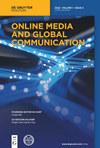Racism, Death, and Protests in Brazil: digital and traditional news coverage of Black Awareness Day after a racism crime on Twitter
引用次数: 0
Abstract
Abstract Purpose On November 19, 2020, a man was brutally murdered by security guards of a supermarket chain located in a city in the very south of Brazil, home to the world’s largest Afro-Black community outside Africa. This killing triggered protests across the country, as a Black man was killed one day before Black Awareness Day. This large popular mobilization happened at the end of 2020 and resembled the George Floyd protests. Despite the anger resonating across communities in Brazil and abroad, the news media coverage on social media resulted in an inequitable distribution of editorial space to both the affective and critical dimensions. As users often adopt view-based practices by not clicking on social media content shared through URLs, it is essential to understand how news media portrays content in short text posted online. Study design Under the lens of news frame and social media theories, our study was built on a multi-method approach combining computational, quantitative, qualitative methods to understand how news media portrays content in a tweet. To do so, we collected 267,576 tweets. They were filtered through the case’s perspective and analyzed using frame theory. Findings Results show that Brazilian news media value different angles concerning Mr. Freitas’s death and subsequent events. While traditional media tends to be more neutral in portraying protests and the killing, digital media raised the debate on the issue and about racism in the country, highlighting protests and using supporting hashtags. Furthermore, cultural hybridity can be seen in Brazil with Black Lives Matter (BLM) movement. Practical and social implications In a media system that shares some aspects with those found in the United States, such as highly commercial media, our study demonstrates the importance of digital media for articulating racial issues and segregation in Brazil. Originality/value A long tradition of scholarship in sociology and communication studies has investigated how news media frames social movements and the impact this coverage might have on protesters and their ability to gather public support in Western-rich democracies. Less well documented is the use of news frames in Brazil. Furthermore, it shows how BLM is hybridized with local topics and has gained traction with digital media outlets. This study aims to fill this gap by becoming the first study investigating how news media frames social movements against racism in Brazil.巴西的种族主义、死亡和抗议:推特上种族主义犯罪后黑人意识日的数字和传统新闻报道
摘要目的2020年11月19日,一名男子被巴西南部一座城市的连锁超市保安残忍杀害,该城市是非洲以外世界上最大的非裔黑人社区的所在地。这起谋杀事件引发了全国各地的抗议活动,一名黑人男子在黑人意识日前一天被杀。这场大规模的民众动员发生在2020年底,类似于乔治·弗洛伊德的抗议活动。尽管愤怒在巴西和国外的社区中引起了共鸣,但社交媒体上的新闻媒体报道导致了编辑空间在情感和批评层面的不公平分配。由于用户通常采用基于视图的做法,不点击通过URL共享的社交媒体内容,因此了解新闻媒体如何在网上发布的短文本中描绘内容至关重要。研究设计在新闻框架和社交媒体理论的视角下,我们的研究建立在一种结合计算、定量和定性方法的多方法方法基础上,以了解新闻媒体如何在推文中描绘内容。为此,我们收集了267576条推文。它们通过案例的视角进行过滤,并使用框架理论进行分析。调查结果显示,巴西新闻媒体对弗雷塔斯先生之死及随后发生的事件有不同的评价角度。虽然传统媒体在描述抗议和杀戮时往往更加中立,但数字媒体通过强调抗议活动和使用支持性标签,引发了关于这个问题和该国种族主义的辩论。此外,在巴西,可以看到黑人生命攸关运动的文化混杂。实际和社会影响在一个与美国有一些共同方面的媒体系统中,例如高度商业化的媒体,我们的研究表明了数字媒体在阐述巴西种族问题和种族隔离方面的重要性。原创性/价值社会学和传播学研究的长期学术传统调查了新闻媒体如何构建社会运动,以及这种报道可能对抗议者及其在西方富裕民主国家获得公众支持的能力产生的影响。巴西使用新闻框架的情况记录较少。此外,它还展示了BLM如何与当地话题相结合,并在数字媒体中获得了吸引力。这项研究旨在填补这一空白,成为第一项调查新闻媒体如何报道巴西反对种族主义的社会运动的研究。
本文章由计算机程序翻译,如有差异,请以英文原文为准。
求助全文
约1分钟内获得全文
求助全文
来源期刊

Online Media and Global Communication
Communication, Media Studies, Internet Studies, International Studies, International Relations-
自引率
0.00%
发文量
0
期刊介绍:
Online Media and Global Communication (OMGC) is a new venue for high quality articles on theories and methods about the role of online media in global communication. This journal is sponsored by the Center for Global Public Opinion Research of China and School of Journalism and Communication, Shanghai International Studies University, China. It is published solely online in English. The journal aims to serve as an academic bridge in the research of online media and global communication between the dominating English-speaking world and the non-English speaking world that has remained mostly invisible due to language barriers. Through its structured abstracts for all research articles and uniform keyword system in the United Nations’ official six languages plus Japanese and German (Arabic, Chinese, English, French, Russian, Spanish, Japanese, and German), the journal provides a highly accessible platform to users worldwide. Its unique dual track single-blind and double-blind review system facilitates manuscript reviews with different levels of author identities. OMGC publishes review essays on the state-of-the-art in online media and global communication research in different countries and regions, original research papers on topics related online media and global communication and translated articles from non-English speaking Global South. It strives to be a leading platform for scientific exchange in online media and global communication.
For events and more, consider following us on Twitter at https://twitter.com/OMGCJOURNAL.
Topics
OMGC publishes high quality, innovative and original research on global communication especially in the use of global online media platforms such as Facebook, TikTok, YouTube, Twitter, Instagram, WhatsApp, Weibo, WeChat, Wikipedia, web sites, blogs, etc. This journal will address the contemporary concerns about the effects and operations of global digital media platforms on international relations, international public opinion, fake news and propaganda dissemination, diaspora communication, consumer behavior as well as the balance of voices in the world. Comparative research across countries are particularly welcome. Empirical research is preferred over conceptual papers.
Article Formats
In addition to the standard research article format, the Journal includes the following formats:
● One translation paper selected from Non-English Journals that with high quality as “Gems from the Global South” per issue
● One review essay on current state of research in online media and global communication in a country or region
 求助内容:
求助内容: 应助结果提醒方式:
应助结果提醒方式:


